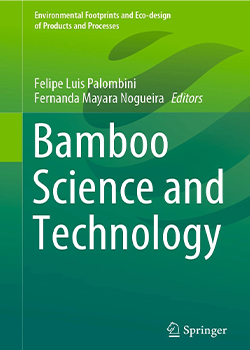
Bamboo-Based Forest Landscape Restoration: Practical Lessons and Initiatives to Upscale in Africa
Year of Publication: 2022
Authors: Barnabas Neba N., Arun Jyoti N., Rene Kaam, Djomo Chimi C. & Karol Mezafack L.
Abstract
Studies suggest that the restoration of degraded land through planting bamboo could be a viable strategy for forest landscape restoration. As part of more extensive landscape restoration, planting bamboo in degraded and marginal landscapes have the potential to restore its productive use and ecosystem services, thus improving the adaptive capacity and resilience of such systems under the accelerated climate change phenomenon. However, using bamboo in landscape restoration has yet to receive significant attention primarily due to data scarcity, scattered or even missing in the literature, and general poor perception, thus contributing to less attention at policy and development planning levels. The lack of adequate information has hindered the potential usefulness of bamboo in landscape restoration and climate change adaptation and mitigation. Therefore, this chapter aims to review and assemble existing knowledge on bamboo resources related to its ability to restore the degraded forest landscape and its contribution to climate change mitigation and adaptation. The chapter, therefore, also aims to highlight promising practices deemed viable to inform decision-makers and to upscale in Africa, which has a bamboo potential of about 115 species covering 7.2 million ha. We highlighted specific key characteristics of bamboo in forest landscape restoration, such as rapid growth, soil binding, and erosion control properties, adaptive capability, nutrient and water conservation, and the provision of a continuous and permanent canopy. Furthermore, we examined its contributions to direct and indirect human well-being through ecosystem services. It is concluded that bamboo has enormous potentiality in landscape restoration vis-a-vis climate change adaptation and mitigation. Finally, it is suggested to initiate an action call for good practices to restore degraded forest landscapes in Africa within frameworks of initiatives such as the REDD + strategy, Bonn Challenge, Afr100 initiative, and the Great Green Wall incorporating bamboo as one of the essential components.ssif. The landscape of TRIDOM has not experienced any significant land use change during the period after the signing of the cooperation agreement. Historical rates of deforestation are low during the period under study. They are estimated at 0.042% and 0.030% respectively for the period 1992-2005 and the period 2005-2018. These low rates of deforestation seem to be due to the measures taken to secure and sustainably manage the massif taken by the three countries, the low population density in this area and the still difficult level of accessibility of a large part of the massif.
